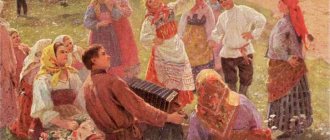The Jews are an ancient people who sacredly honor their traditions and zealously follow the tenets of their faith. A Jewish wedding in many ways remains the personification of those commandments that Moses left in the 13th century BC, and according to some sources, the origins of Jewish rituals and traditions go back even further, into the depths of centuries. Although many rituals changed over time - they were improved, outdated details were discarded and something new was added, traditional celebrations retained a unique national flavor.
Ancient traditions
Since ancient times, the parents of the newlyweds have agreed on the wedding. The bride and groom met after reaching agreements, often seeing each other for the first time. Since quite a lot of time passed before the wedding ceremony, in some regions the arranged young people began to live together without waiting for officially formalized marriage bonds.
A wedding in Israel and the institution of marriage in general were perceived not only as the unity of a man and a woman for procreation, but also as the embodiment of the Divine command. After all, according to the Torah, someone who has not created a family is not a full-fledged person. He is not complete - somewhere in the world, just as separately, his half lives.
Collusion (engagement)
This event provides for an agreement between both parties (bride, groom and their parents) regarding the marriage. It is usually fixed in writing, but it can also be an oral agreement.
The material participation of each parent is immediately discussed here, both in conducting the marriage ceremony and in the subsequent provision of the newly created family with the necessary things to start living together.
After the agreement is announced, both mothers, according to tradition, beat a round dish (plate). This indicates the irrevocability of the concluded agreement: just as it is unrealistic to return the plate to its original form, the process of perfect collusion will also be irrevocable.
Everything is consolidated with a small meal, in which only relatives participate.
Matchmaking and engagement rituals
Long holiday celebrations began with mandatory matchmaking. The consent of the young couple was not required for marriage - it was believed that good sons and daughters should be obedient to the will of their parents. Representatives of the groom talked about the candidate (very rarely the matchmaking was carried out by the groom himself). If consent was obtained from the girl’s relatives, a bride price was paid as a sign of serious intentions and proof of financial solvency.
Then the girl’s parents and representatives of the groom, or the groom himself, sat down at the table with the obligatory wine to discuss the details of the upcoming celebrations. The Jews were among the first to enter into marriage contracts. They specified both the size of the dowry and ransom, as well as the responsibilities of the future spouses. Particular attention was paid to abuse of wife and children. In the event of a proven violation of the terms of the contract, the marriage could be dissolved without long delays.
As a sign of consolidating the agreement reached, the mothers of the young people broke the plate. This meant that there was no return to the old life, just as it was impossible to glue dishes from fragments.
After resolving all the issues that arose, they organized an acquaintance of the bride and groom, always in the presence of a rabbi or respected people. It often happened that the newlyweds did not see each other until the wedding.
Nowadays such harsh conditions are found only in orthodox families. Usually young people get to know each other on their own and only then notify the older generation of their desire to start a family.
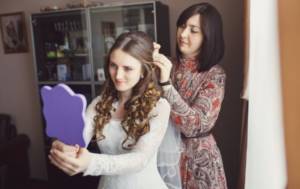
Bride and groom outfits
If the newlyweds do not want to get married, but only plan to have a symbolic wedding in picturesque places in Israel, there are no restrictions on the choice of wedding dresses. The bride can choose a dress of any style, be it a ballroom model with a full skirt and corset or a tight-fitting version with a lace back and dropped shoulders. The color of the outfit is usually chosen to be white; in it, the girl will look most harmonious against the backdrop of the beauty of Israel. Not just any dress is suitable for a wedding. It is necessary that the girl’s shoulders and head are covered, preferably with a veil, and that the neckline is not deep.
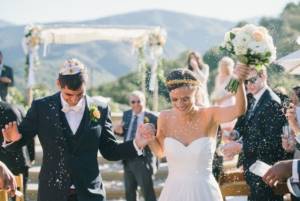
To complement the look, the bride needs to choose classic pumps, preferably plain, without decorations. The hairstyle can be in the form of a strict styling or loose curls. It is recommended to keep your makeup natural so that your face does not stand out against the background of restraint that reigns in this country.
Attention! The bouquet can be compact or lush; compositions of roses or orchids look best.
You can add a touch of originality with the help of an openwork umbrella, gloves, veil and jewelry. It is better to purchase a bride's dress in Israel - it will be more economical.
The requirements for the groom's suit are standard - a classic two or three piece. The shade can be black, gray or blue. Some young people will suit options from a pastel palette. The jacket can be removed if desired if there is a vest. The shoes should be classic, and the boutonniere should be made from the same plants as the bride’s bouquet.
Preparations for a Jewish wedding
The preparatory period was very important for the proper organization of the celebrations. The beliefs and traditions of the Jews contained, and still contain, many restrictions that had to be taken into account when preparing for the wedding. Thus, a Jewish wedding was in no case celebrated during the period of national holidays, fasts and memorial days. Saturday, the Sabbath, was also forbidden. The day when the Almighty rested from work was a general day off for Jews, when all labor activity was prohibited. In the modern world, this tradition is observed to the point of making it impossible to independently press the elevator button or turn on the light. Of course, there is no time for marriages here.
Groom Announcement
A week before the wedding celebrations, the groom publicly announced the upcoming event. This happened during a service in the synagogue. The ritual was called Ufruf. The men present at the service actively congratulated the happy newlywed and showered him with sweets. After which the whole family gathered for a festive dinner.

Bride's cleansing rituals
The girl underwent cleansing rituals in a special Mikveh pool. She completely undressed, even the nail polish had to be removed. She took off all her jewelry and slowly sank into the water, reading prayers. There had to be several ablutions. She was supported by a company of friends and married women who helped and held conversations about the value of family life. These ablutions meant her cleansing of the sins of her past life and preparation for marriage.
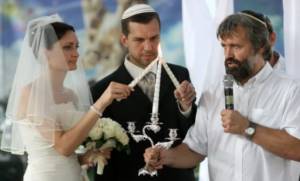
The main thing is the soul
In many countries, during the wedding ceremony, the groom removes the veil from the bride's face. However, Jewish suitors, on the contrary, cover for her. This procedure is called badeken and is a very important part of most Jewish weddings.
Every girl strives to look her best on such an important day. Jewish brides are no different from others in this regard. So why should the groom hide his beloved's face? In this way, he demonstrates that he fell in love with her for her character and soul, and not for her external beauty. By covering the bride, the groom also takes upon himself the obligation to protect, clothe and provide for her.
Vitamin A (animal products) and carotenoids are necessary for the immune response
Janitors are also in the lead: Russians named the most noble profession
A man has invested £4.5 million in an abandoned gatehouse. The house turned out luxurious
Jewish wedding celebrations
The wedding could be scheduled on different days, according to established rules. According to one of them, the wedding took place on Wednesday, so that on Thursday, if the girl lacked virginity, the husband could publicly divorce in the synagogue.
Celebrated on weekdays during the week, and on Saturday after a late dinner. Sunday remains the most popular.
Wedding outfits
Jews do not wear any special wedding attire. They dressed in elegant clothes of the region where they lived. Modern wedding dresses and suits have a very classic look. The only condition is that the bride’s dress should be as modest and closed as possible.
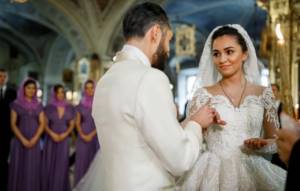
Morning of the wedding day
On the wedding day, the legal issues of the upcoming marriage were first resolved. The groom, together with the bride's representatives, guests and rabbis, signed the engagement agreement and the marriage contract. Meanwhile, the bride received congratulations and gifts in the women's quarters. And the mothers of the newlyweds broke something glass in memory of the destroyed Temple of Jerusalem.
Then the groom, in the presence of respected witnesses, threw a long thick veil over the bride’s head, which completely hid her - as a sign that the man was now fully responsible for his wife. The presence of strangers was necessary to make sure that the girl was not replaced.
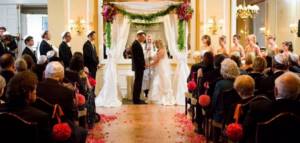
Wedding - chuppah
The name of the most important rite comes from the name of the canopy. His presence over the heads of the newlyweds was mandatory. This fabric, decorated with fringe and embroidery, on four carved pillars symbolized the canopy of the groom's house, under which he introduced his wife. The open sides represented hospitality, because this is how the tent of Abraham was opened to all those who suffered. There should not have been any furniture in the chuppah, because a Jewish home is not things, it is the people living in it. Traditionally, there was supposed to be an open sky above the canopy, so the ceremonies were performed outdoors.
The man was the first to enter his “house”, after which the woman entered and walked around the groom in a circle three or seven times - a sacred number. The position of a wife in a Jewish family was special, unlike either Muslim or European customs. Despite the external signs, which are quite similar to those of the East, Jewish women were the cement that held together family ties. They were educated, smart and much less limited in their capabilities.
The rabbi read prayers, blessed the wine in a crystal goblet, and allowed the groom to put on his wedding ring. According to Jewish customs, the ring was intended only for the wife. It was simple, without stones or frills, flat. After this, blessing prayers were read, and the young people drank wine from a goblet. The groom broke the empty vessel - threw it on stones or stepped on it with his right foot. And the guests shouted: “Happy fate!” Modern newlyweds often replace the glass with an incandescent light bulb - it is easier to hit and much louder.
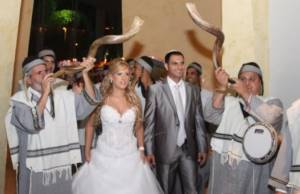
Festive feast
The Jewish people have always had a very specific attitude towards food. Therefore, exclusively kosher dishes were prepared for the festive banquet. But the Torah did not forbid having fun, singing songs and dancing, so we walked from the heart. All guests were expected to entertain the newlyweds to the best of their ability. The holiday lasted until sunrise.
National dances and entertainment
From time immemorial, dancing at a Jewish holiday has been the main way to have fun. Many different traditional dances have been invented specifically for weddings. Many of them still dance.
- The dance for the bride included the use of various funny little things - jump ropes, confetti, flags and fancy dress costumes, everything that dear guests could think of.
- If the last daughter was married, then her mother was crowned with a flower wreath and went out to the center of the hall, and all her daughters danced around her.
- If the last child of either sex was married, a separate dance was held for the parents.
- The Hora and Mitzvah were danced when respected people danced with or for the bride, holding belts in their hands. After which the bride and groom made a joint exit.
The Jewish wedding took place to live national music with rare inclusions of musical compositions from the region of residence, because these people settled all over the world. Modern weddings also include national compositions and dances, and generally accepted playlists.
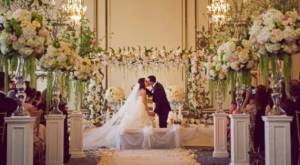
Interesting customs of a Jewish wedding
Like all other peoples, Jews have their own original traditions and signs, which they strictly observe during the wedding - after all, the well-being and happiness of the newlyweds depends on this. Particularly interesting in this regard are the weddings of Orthodox Jews, which have remained virtually unchanged since ancient times.
- Since marriage is a sacred act for the bride and groom, they are forbidden to eat or drink anything other than clean water until the sacrament of betrothal.
- All traditional Jewish rituals have their origins in the Torah. They are very religious and strictly observe the commandments and laws of God.
- After the engagement, the newlyweds must retire to a separate room in the presence of several witnesses and share a meal together. After this, the official part of the wedding ends.
- At the festive feast, the newlyweds were necessarily lifted into the air along with the throne-chairs, and carried around in a circle with songs and congratulations.
- The young people at the wedding are the embodiment of Divine providence, they are full of holiness and their status is higher than everyone else present, regardless of merit and age. The attitude towards them these days is appropriate. For many young people, the period of marriage is the most important in life.
- As in the Muslim tradition, Jews do not celebrate together between men and women. During special events and banquets, it is customary to separate according to gender, and separate tables are placed.
- A married woman should not show her hair to anyone except her husband. Therefore, in public they appear either in completely closed headdresses, scarves, or shawls. Or - in wigs.
- The end of the holiday is marked by a prayer of thanks.
- The custom of throwing a bouquet into a crowd of girlfriends began its victorious march precisely from the Jewish tradition.
- At many weddings there is still an official jester-toastmaster, badchen. He entertains guests, organizes competitions and various jokes.
- There is a wonderful old custom that is still observed: when a son is born, parents plant a cedar tree, and if a daughter is born, a pine tree.
Even zealous keepers of traditions give in under the pressure of modern technology. Increasingly, celebrations are being filmed on video or with cameras, although previously it was strictly forbidden to record secret rituals and people in general.
Oh, did this wedding sing and dance?
And, the last thing is the best part (no, again not what you thought!): a wedding banquet, traditionally lasting seven days with the invitation of everyone, everyone, including neighbors, police, ambulance and a large number, as a rule, innocent citizens.
Usually the wedding ceremony is held in a synagogue, and the banquet is held anywhere: a restaurant, a nightclub or a specially rented “celebration hall”. However, from the point of view of observing Jewish traditions, it is better to organize it in a kosher restaurant - with songs, dances, ethnic music, a toastmaster-rabbi, gifts, congratulations, blackjack and whores, a guest photographer and wine.
But now, the wedding feast is over, the guests and relatives have gone home, and the bride and groom go to wash the dishes... Just kidding: they have a much more important matter - their wedding night, but more on that, dear boys and girls, some other time once!

Capitalist wedding

Sergey Gerasimov. Frontispiece to Maxim Gorky’s novel “The Artamonov Case” (fragment). 1937. Publishing house "Soviet Artist", Moscow
Maxim Gorky wrote the novel “The Artamonov Case” about a family of provincial industrialists in 1925, but the action takes place in pre-revolutionary times. The wedding of Pyotr Artamonov and Natalya is a vivid example of a “generation gap,” when young people began to perceive patriarchal traditions as deep prejudices.
When Peter followed her into Natalya’s room, where a luxurious bed had been prepared, the old woman sat down heavily on a chair in the middle of the room. - Listen, yes - don’t forget! - she said solemnly. - Here are two half rubles for you, put them in your boots, under the heel; Natalya will come, kneel down, want to take off your boots, - don’t let her... - Why is that? - Peter asked gloomily. - None of your business. Three times - you won’t give it, but on the fourth - allow it, and then she will kiss you three times, and you give her fifty dollars, say: I give you, my servant, my destiny! Remember! Well, undress and lie down with your back to her, and she will ask you: let him spend the night! So you - be silent, just hold out your hand to her for the third time - understand? Well, then... Peter looked in amazement at the dark, wide face of his mentor, flaring his nostrils, licking his lips, she wiped her fat chin and neck with a handkerchief and authoritatively, clearly pronounced rude, shameless words, repeating goodbye: “Don’t believe in screams, don’t trust in tears.” believe. “She staggered out of the room, leaving a drunken smell behind her, and Peter was overcome by a fit of anger - he tore his boots off his feet and threw them under the bed...
Marriage contract
Even if the bride-to-be has worn a diamond or gold ring for years, in many Jewish communities the couple is not considered engaged until a special document is signed detailing the terms of the future engagement. Canceling a wedding after it has been signed is considered extremely undignified, so if it is used, in almost all cases it is signed on the wedding day. However, this actually means that the couple was not engaged until the day of marriage. In ancient times, such agreements were drawn up so that families could negotiate the dowry in advance and establish a fine in case of divorce.
It only took three weeks. The guy decided to renovate his mother’s apartment himself: photo
Life will change. The new moon in mid-January will bring good luck to the 4 zodiac signs
Harvard professor studied dreams during a pandemic: what they are about and how to resist
Proletarian wedding

A still from Leonid Gaidai’s feature film “It Can’t Be!” (short story “The Wedding Incident”) (1975)
In 1933, the Leningrad Music Hall presented Mikhail Zoshchenko's one-act vaudeville "Wedding". Two years later, the writer published a collection of short stories, “The Blue Book,” which included the short story “The Wedding Incident.” Both the story and the play ridiculed the frivolous attitude of Soviet youth towards civil (non-church) marriage: if I want, I’ll sign up, if I want, I’ll get divorced. The main character could not recognize the bride at his own wedding - an unfamiliar girl - and mistakenly kissed another.
Volodka shouts: “And the dog will sort you out!” They impaled different women, and I have to figure it out. Here the bride appears in a white robe. And he holds flowers in his hands. “Oh, so,” he says, “well, this will backfire on you.” And again, of course, screams, screams and hysterics. Of course, the relatives began to kick Volodka out of the apartment. Volodka says: “At least let me eat.” In the morning, he says, without eating such a hassle. But the relatives pushed and threw Volodka onto the stairs. The next day, Volodya Zavitushkin went to the civil department after work and got divorced.
In 1975, director Leonid Gaidai based the stories of Mikhail Zoshchenko on a collection of short stories called “It Can’t Be!” The main characters from “The Wedding Incident” were brilliantly played by Leonid Kuravlev and Valentina Telichkina.
Bourgeois wedding

Still from Viktor Ivanov’s feature film “Chasing Two Hares” (1961)
In 1875, the Ukrainian writer Ivan Nechuy-Levitsky wrote the comedy “On Kozhumyaki”. The author ridiculed the morals of the Kyiv townspeople, who strived for a beautiful, “French” life. In 1883, the play was adapted by Mikhail Staritsky. By agreement with Nechuy-Levitsky, the comedy was called “Lady’s Lip, That Has No Teeth,” and the subtitle was “Chasing Two Hares.” The premiere took place in the same 1883 at the Bergonier Theater in Kiev.
Noble wedding

Orest Vereisky. Illustration for Leo Tolstoy’s novel “Anna Karenina” (fragment). Image: illustrators.ru
The hero of Leo Tolstoy's novel Anna Karenina, landowner Konstantin Levin, did not immediately achieve the reciprocity of Princess Kitya Shcherbatskaya. And yet their marriage became a marriage of love. The description of the wedding in the novel is also a valuable evidence of the era. For example, the newlyweds were offered to go to Europe after the wedding, as was customary among aristocrats, but the bride decided to go to her husband in the village. The act seemed strange for the born princess, but it gave contemporaries a better understanding of the character of the heroine. Tolstoy also paid great attention to economic details.
...When Levin demanded to get dressed, Kuzma, Levin’s old servant, brought a tailcoat, a vest and everything that was needed. - And the shirt! - Levin screamed. “The shirt is on,” Kuzma answered with a calm smile. Kuzma did not think of leaving his shirts clean, and, having received orders to pack everything and take it to the Shcherbatskys, from whom the newlyweds were leaving that very evening, he did so, packing everything except the pair of tails. The shirt, put on in the morning, was wrinkled and impossible with the open fashion of vests. It was too far to send to the Shcherbatskys. They sent me to buy a shirt. The footman returned: everything is locked - Sunday. They sent to Stepan Arkadyevich. They were waiting for the groom in the church, and he, like an animal locked in a cage, walked around the room, looking into the corridor and remembering with horror and despair what he had said to Kitty and what she could now think. - We've arrived! - Here he is! - Which? - Younger, or what? - and she, mother, is neither alive nor dead! - they started talking in the crowd when Levin, having met the bride at the entrance, entered the church with her.
Wedding of a minor employee

Still from the feature film “Wedding” by Isidor Annensky (1944)
In 1884, Anton Chekhov’s story “A Wedding with a General” was published in the humorous magazine Oskolki. The custom of inviting a significant person “in rank” to a wedding actually existed among merchants. Chekhov ridiculed the attempt of a small employee - a loan appraiser - to follow merchant fashion.
At 11 o'clock Nyunin came to pick up his uncle. Revunov-Karaulov put on his uniform and trousers with gold stripes, put on his medals - and off they went. The wedding dinner had already begun when the footman hired from the tavern was taking off the admiral's hooded coat, and the groom's mother, Mrs. Lyubimskaya, meeting him in the hall, narrowed her eyes at him. - General? - she sighed, looking questioningly at Andryusha, who was taking off his coat, and bowing. - Very nice, Your Excellency... But how unprepossessing... stale... Hm... There is no strictness in appearance and not even e-flights... Hm... Well, it doesn’t matter, don’t toss and turn, God willing... So be it, please, Your Excellency! Thank God, at least there are many orders...
In 1889, Chekhov used this plot in his one-act play “The Wedding.” Vaudeville was immediately adopted into the repertoire of many amateur troupes. Actress Olga Knipper wrote about one of these performances in 1900: “The other day Tolstoy was at Chekhov’s Evening and laughed, they say, until he dropped, and he really liked it.” In 1902, “The Wedding” was finally staged on a professional stage - at the Alexandrinsky Theater. In 1944, the film “Wedding” was made based on Chekhov’s works, in which the main roles were played by Faina Ranevskaya, Erast Garin, Zoya Fedorova and Alexey Gribov. And the expression “wedding general” has become a household word.


